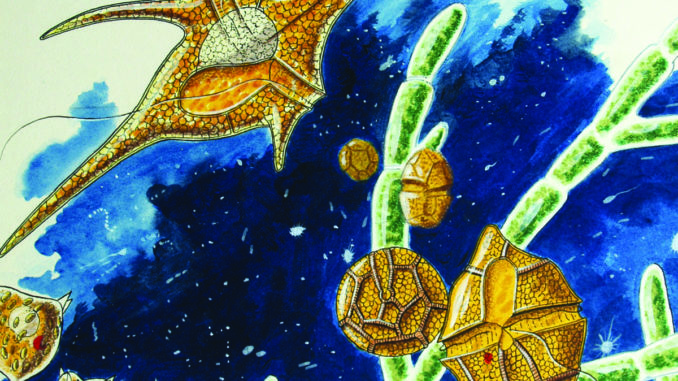
Bio Bites
By R. Gary Raham
A biologist-artist’s ruminations about our roles in a science-inspired world
Biologists get excited about the strangest things. In my case, I’ve always had a fondness for the myriad forms that microscopic pond creatures have evolved over the eons: single cells made with glass shells, blobs of protoplasm radiating spikes, big hollow balls coated with fluttering tails, and strings of cells connected like boxcars on enormous aquatic trains. Non-biologists, not privy to microscopic views of these creatures, may dismiss their aggregations as merely slime and move on—as quickly as possible. But the living world owes its very existence—and perhaps its future on Earth—to slime.
Ruth Kassinger wrote a fascinating book titled Slime with the subtitle “How algae created us, plague us, and just might save us.” I haven’t finished the book yet, but I am intrigued by the picture she paints of the early Earth, 3.7 billion years ago, when slime was all there was—a time before slime remade the Earth and transformed itself into us and everything we know. The artist in me is now primed to paint a picture of this early version of our planet in all its weirdness.
Earth was still a warm water world 3.7 billion years ago, but breathing its atmosphere would have been deadly. The air contained a mix of carbon dioxide, methane, hydrogen, carbon monoxide, and nitrogen, spiced with sulfur dioxide. Although the sun was only 70% as bright as it is today, these gases did serve as an insulating blanket that kept temperatures reasonable for living things even under a dimmer sun. Water could exist in all its phases: liquid, solid, and gas. The moon, formed roughly a billion years earlier during a collision between Earth and a Mars-sized body of rock, had not yet spiraled out to its current orbit. It would have hung in the sky like an enormous globe ten times bigger than the one we admire on our favorite lover’s lane. The Earth itself rotated twice as fast. The sun rose and set with a six-hour rhythm.
Life flourished—slime flourished—in Earth’s early oceans, but it was not our slime. Early cells were chemoautrotrophs, a fancy term for creatures that could use chemicals like hydrogen sulfide to generate energy and make the proteins, carbs, and fats necessary for life. Perhaps a few hundred million more years would pass before life found a more dynamic way to live—a path that involved using solar energy to fuse carbon compounds together, yielding water and oxygen as byproducts. Cyanobacteria (blue-green slime, formerly known as blue-green algae) invented photosynthesis.
The oxygen produced by photosynthesis was toxic prehistoric pollution—bad news for chemoautotrophs—but a billion years would pass before oxygen would combine with all the iron it could find, both on land and in the oceans, and begin to change the atmosphere. Eventually, oxygen forced chemoautotrophs into seclusion, but it made a world suitable for humans and all the life that we hold dear.
I’m anxious to finish Kassenger’s book and find out how she thinks slime may save us from our own brands of toxic pollution. I’ll be sure to share. But first, I have a haunting scene I want to paint.
Support Northern Colorado Journalism
Show your support for North Forty News by helping us produce more content. It's a kind and simple gesture that will help us continue to bring more content to you.
BONUS - Donors get a link in their receipt to sign up for our once-per-week instant text messaging alert. Get your e-copy of North Forty News the moment it is released!
Click to Donate
